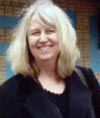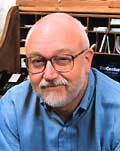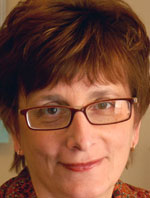Teaching and Working in a Multimedia World
> Index | Panel 1 | Panel 2 | Panel 3 | Panel 4 | Panel 5
Experience From On-Campus: Multimedia Reporting
 Larry
Dailey (panel moderator) holds the Reynolds Chair of Media Technology
and is a professor of journalism at the Donald W. Reynolds School of Journalism,
University of Nevada, Reno. There he teaches courses in nonlinear documentary
multimedia storytelling, photojournalism and game design for journalists.
Previously, he was an assistant professor of journalism and the director
of the Digital Media Minor at Ball State University in Muncie, Indiana. He
has also been a journalism instructor at Southern Illinois University - Edwardsville.
Prior to that, he taught multimedia and advanced photojournalism courses
as a visiting assistant professor at the University of Missouri - Columbia.
He worked for three years as a multimedia producer for MSNBC Interactive.
He has also worked as picture editor for the Associated Press and United
Press International in Washington. And he has worked as a newspaper photographer
and photography department manager. Larry holds a master’s degree in
photography from the S.I. Newhouse School of Public Communications at Syracuse
University. He also holds degrees in journalism and education from the University
of Missouri.
Larry
Dailey (panel moderator) holds the Reynolds Chair of Media Technology
and is a professor of journalism at the Donald W. Reynolds School of Journalism,
University of Nevada, Reno. There he teaches courses in nonlinear documentary
multimedia storytelling, photojournalism and game design for journalists.
Previously, he was an assistant professor of journalism and the director
of the Digital Media Minor at Ball State University in Muncie, Indiana. He
has also been a journalism instructor at Southern Illinois University - Edwardsville.
Prior to that, he taught multimedia and advanced photojournalism courses
as a visiting assistant professor at the University of Missouri - Columbia.
He worked for three years as a multimedia producer for MSNBC Interactive.
He has also worked as picture editor for the Associated Press and United
Press International in Washington. And he has worked as a newspaper photographer
and photography department manager. Larry holds a master’s degree in
photography from the S.I. Newhouse School of Public Communications at Syracuse
University. He also holds degrees in journalism and education from the University
of Missouri.
 Gary
Hanson is a 25-year veteran of television news. From 1984 to
1997 he was News Director of WKBN, the CBS television affiliate in Youngstown,
Ohio. He is the past Freedom and Responsibility Chair of the RTV-J Division
of AEJMC, the Association for Education in Journalism and Mass Communication.
Hanson is a Past Chairman of the Radio-Television News Directors Association,
representing 3800 broadcast and cable journalists around the world. Hanson
is the winner of 3 National Association of Television Arts and Sciences Regional
EMMY awards in the Cleveland region for his work as principal reporter on
the WKBN TV public affairs broadcast "Newswatch Sunday." Prior
to joining WKBN, Hanson was News Director of KXON-TV in Mitchell, South Dakota.
He began his television career at WDAZ TV in Grand Forks, North Dakota in
1971. He earned a B.A. in Speech from the University of North Dakota in 1973.
Hanson received his master's degree from the School of Journalism and Mass
Communication at Kent State University, where he serves as an assistant professor.
He is the faculty adviser for TV2, KSU's student television station.
Gary
Hanson is a 25-year veteran of television news. From 1984 to
1997 he was News Director of WKBN, the CBS television affiliate in Youngstown,
Ohio. He is the past Freedom and Responsibility Chair of the RTV-J Division
of AEJMC, the Association for Education in Journalism and Mass Communication.
Hanson is a Past Chairman of the Radio-Television News Directors Association,
representing 3800 broadcast and cable journalists around the world. Hanson
is the winner of 3 National Association of Television Arts and Sciences Regional
EMMY awards in the Cleveland region for his work as principal reporter on
the WKBN TV public affairs broadcast "Newswatch Sunday." Prior
to joining WKBN, Hanson was News Director of KXON-TV in Mitchell, South Dakota.
He began his television career at WDAZ TV in Grand Forks, North Dakota in
1971. He earned a B.A. in Speech from the University of North Dakota in 1973.
Hanson received his master's degree from the School of Journalism and Mass
Communication at Kent State University, where he serves as an assistant professor.
He is the faculty adviser for TV2, KSU's student television station.
 Chris
Harvey has been immersed in new media for about a decade, but has
also worked as a magazine editor, a newspaper reporter and a journalism teacher.
She left her job as managing editor at American Journalism Review in August
2000 to build the online curriculum at the University of Maryland Philip
Merrill College of Journalism. She created and now edits the college's award-winning
online newsmagazine, Maryland Newsline, which is staffed by students. She
also teaches an introductory online journalism course. Before coming to AJR,
Harvey worked as an associate editor at washingtonpost.com. There, she led
a content redesign of the Metro section and edited news and feature stories.
She earlier taught reporting and editing at UMD's College of Journalism and
ran the student-staffed Capital News Service print bureaus in Washington
and Annapolis. She has held reporting and editing jobs at several newspapers,
including The Washington Times.
Chris
Harvey has been immersed in new media for about a decade, but has
also worked as a magazine editor, a newspaper reporter and a journalism teacher.
She left her job as managing editor at American Journalism Review in August
2000 to build the online curriculum at the University of Maryland Philip
Merrill College of Journalism. She created and now edits the college's award-winning
online newsmagazine, Maryland Newsline, which is staffed by students. She
also teaches an introductory online journalism course. Before coming to AJR,
Harvey worked as an associate editor at washingtonpost.com. There, she led
a content redesign of the Metro section and edited news and feature stories.
She earlier taught reporting and editing at UMD's College of Journalism and
ran the student-staffed Capital News Service print bureaus in Washington
and Annapolis. She has held reporting and editing jobs at several newspapers,
including The Washington Times.
 Edgar
Huang is an associate professor in the IUPUI School of Informatics.
His journal articles on media convergence, streaming media, copyright issues
concerning DVD ripping, online imaging, documentary photography history,
digital imaging manipulation, and the Internet and national development are
seen in Convergence, Journalism and Communication Monographs, Visual Communication
Quarterly, Information Technology for Development, etc. Huang's documentary
photography of the Tiananmen Student Movement in 1989 is in the permanent
collection on China New Digest (CND.ORG).
He won national awards for his video and Web productions. Huang has taught
media convergence, video production and editing, photojournalism, Web publishing,
graphic and layout design, research methods, computer-assisted reporting
and news writing courses in different universities since 1984. He has served
in the AEJMC VisCom Division for multiple years. Huang received his Ph.D.
degree in Mass Communication from Indiana University in 1999 and M.F.A. degree
in Visual Arts from UC, San Diego, in 1995.
Edgar
Huang is an associate professor in the IUPUI School of Informatics.
His journal articles on media convergence, streaming media, copyright issues
concerning DVD ripping, online imaging, documentary photography history,
digital imaging manipulation, and the Internet and national development are
seen in Convergence, Journalism and Communication Monographs, Visual Communication
Quarterly, Information Technology for Development, etc. Huang's documentary
photography of the Tiananmen Student Movement in 1989 is in the permanent
collection on China New Digest (CND.ORG).
He won national awards for his video and Web productions. Huang has taught
media convergence, video production and editing, photojournalism, Web publishing,
graphic and layout design, research methods, computer-assisted reporting
and news writing courses in different universities since 1984. He has served
in the AEJMC VisCom Division for multiple years. Huang received his Ph.D.
degree in Mass Communication from Indiana University in 1999 and M.F.A. degree
in Visual Arts from UC, San Diego, in 1995.
 Mindy
McAdams is a professor in the Department of Journalism
at the University of Florida, where she teaches various courses concerning
online journalism. She holds one
of the 21 Knight Chairs in Journalism. Her book Flash Journalism: How
to Create Multimedia News Packages was published by Focal Press/Elsevier
in 2005. She taught graduate courses at a university in Malaysia on a traditional
Fulbright Scholar grant from November 2004 to June 2005. Before moving to
Florida in 1999, she was the Web strategist at the American Press Institute.
In 1994, she was the first content developer at Digital Ink, The Washington
Post’s first online newspaper. Previously, she was a copy editor
for 11 years. She worked on the Metro desk at The Washington Post and
at Time magazine in New York. Her consulting work since 1995 has
taken her to Thailand, Hong Kong, Bulgaria, Denmark, Italy, the Netherlands,
Switzerland, Britain and Canada. She has an M.A. in media studies from The
New School and a B.A. in print journalism from Penn State.
Mindy
McAdams is a professor in the Department of Journalism
at the University of Florida, where she teaches various courses concerning
online journalism. She holds one
of the 21 Knight Chairs in Journalism. Her book Flash Journalism: How
to Create Multimedia News Packages was published by Focal Press/Elsevier
in 2005. She taught graduate courses at a university in Malaysia on a traditional
Fulbright Scholar grant from November 2004 to June 2005. Before moving to
Florida in 1999, she was the Web strategist at the American Press Institute.
In 1994, she was the first content developer at Digital Ink, The Washington
Post’s first online newspaper. Previously, she was a copy editor
for 11 years. She worked on the Metro desk at The Washington Post and
at Time magazine in New York. Her consulting work since 1995 has
taken her to Thailand, Hong Kong, Bulgaria, Denmark, Italy, the Netherlands,
Switzerland, Britain and Canada. She has an M.A. in media studies from The
New School and a B.A. in print journalism from Penn State.
 Rick
Musser is the coordinator for the
University
of Kansas School of Journalism and Mass Communications multimedia newsroom
and head of the News and Information Track. He supervised the design, construction
and start up of the school's new cross-platform newsroom, taking it from
blueprints to daily operation. His position within the School's administration
allows him to lead on-going efforts to merge new media with the established
values and day-to-day teaching within the news program. He is also the Clyde
Reed Teaching Professor. He has won a number of teaching awards during 30
years at KU, including the high-profile W.T. Kemper Fellowship for Teaching
Excellence. He also has taught internationally at the Consortium International
University in Paderno del Grappa, Italy. His professional career includes
a stint as vice president of operations for American City Business Journals,
a chain of more than 30 business weeklies. As a business journalist, he has
published numerous articles for Ingram's Magazine and the Kansas City Star.
Other jobs in journalism have taken him to the South Bend Tribune, the Wichita
Eagle and the Dakotas, where he spent a sabbatical working for Indian Country
Today. Most recently, he worked on the assignment desk and as a field producer
in Chicago, where he spent a month as a Radio and Television News Directors
Foundation fellow working at WGN TV news.
Rick
Musser is the coordinator for the
University
of Kansas School of Journalism and Mass Communications multimedia newsroom
and head of the News and Information Track. He supervised the design, construction
and start up of the school's new cross-platform newsroom, taking it from
blueprints to daily operation. His position within the School's administration
allows him to lead on-going efforts to merge new media with the established
values and day-to-day teaching within the news program. He is also the Clyde
Reed Teaching Professor. He has won a number of teaching awards during 30
years at KU, including the high-profile W.T. Kemper Fellowship for Teaching
Excellence. He also has taught internationally at the Consortium International
University in Paderno del Grappa, Italy. His professional career includes
a stint as vice president of operations for American City Business Journals,
a chain of more than 30 business weeklies. As a business journalist, he has
published numerous articles for Ingram's Magazine and the Kansas City Star.
Other jobs in journalism have taken him to the South Bend Tribune, the Wichita
Eagle and the Dakotas, where he spent a sabbatical working for Indian Country
Today. Most recently, he worked on the assignment desk and as a field producer
in Chicago, where he spent a month as a Radio and Television News Directors
Foundation fellow working at WGN TV news.
 Mary
Spillman is an assistant professor of journalism at Ball State University,
where she also is the program director of the Digital Media Minor. Her research
interests include media history and digital storytelling. Spillman’s
recent work has centered on the effectiveness of staff-produced blogs in
engaging newspaper audiences in conversation. She earned her M.S. from Butler
University in radio-television and completed doctoral courses in journalism
at Indiana University. Spillman previously worked as an editor for The Associated
Press in Indianapolis and as the managing editor of TheIndyChannel.com, the
Web site for WRTV, Indianapolis. She also was a reporter at several radio
and television stations in central Indiana.
Mary
Spillman is an assistant professor of journalism at Ball State University,
where she also is the program director of the Digital Media Minor. Her research
interests include media history and digital storytelling. Spillman’s
recent work has centered on the effectiveness of staff-produced blogs in
engaging newspaper audiences in conversation. She earned her M.S. from Butler
University in radio-television and completed doctoral courses in journalism
at Indiana University. Spillman previously worked as an editor for The Associated
Press in Indianapolis and as the managing editor of TheIndyChannel.com, the
Web site for WRTV, Indianapolis. She also was a reporter at several radio
and television stations in central Indiana.
Note: Bio information and materials provided as received from the panelists and/or panel moderator.